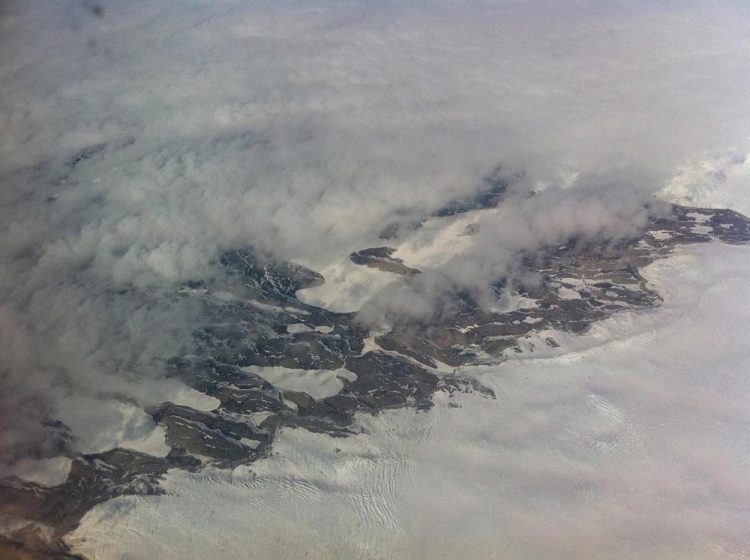Cloudy with a chance of warming

Clouds are shown over the western edge of the Greenland Ice Sheet. Photo by Matt Shupe/CIRES
“As the Arctic atmosphere warms and moistens, it becomes a better insulator. While we expected this to reduce the influence from clouds, which provide additional insulation, we find that clouds forming in the Arctic in these conditions appear to further warm the surface, especially in the fall and winter,” said Christopher Cox, lead author of the new paper published today in Nature Communications.
Cox is a research scientist with the Cooperative Institute for Research in Environmental Sciences (CIRES), who works at NOAA's Earth System Research Laboratory in Boulder, Colorado.
Clouds are a complicated character in the climate change story: They can cool the planet's surface by reflecting sunlight, and they can insulate it and keep it warm.
“To understand why and where Earth is warming, you have to understand the overall effect of clouds,” Cox said.
Head north to the Arctic, and clouds' impact on climate is particularly difficult to understand, he said. The amount and manner in which clouds warm the surface is determined by an intricate dance between moisture (relative humidity), temperatures and the properties of the clouds–and that dance “is different in the Arctic, where the air is colder and drier than at lower latitudes,” Cox said.
To nail down the overarching influence of Arctic clouds on temperatures, he and colleagues from CIRES, NOAA, Washington State University, Idaho and Chile analyzed measurements from three science research stations in the far north: Barrow, Alaska; Eureka, Canada; and Summit, Greenland.
They assessed things like temperature, relative humidity, and a measure of the cloud insulating properties (“the downwelling infrared cloud radiative effect”), and they looked at how those factors interacted with one another (in different parts of the infrared spectrum).
Previous work suggested that as the atmosphere itself warms and becomes more moist it becomes a better insulator, so the clouds themselves have a diminishing contribution to warming. This is likely true on a global scale: It's as if a person is already warm under a blanket and adding another blanket has little additional effect.
However, this team found a different behavior when temperature and humidity increase in the cold Arctic. There, clouds can retain their ability to warm the surface, and actually appear to be amplifying regional warming. In this cold, dry region, adding a second “blanket” can, in fact, make it even warmer.
The effect–strongest in autumn and winter–is related to the way that temperature and moisture are changing relative to each other in the region, according to the new analysis, which relied on climate modeling as well as observations. Because there is little sunlight in the Arctic in autumn and winter, the insulating properties of clouds far outweigh their shading properties, making this result all the more important, said co-author Matthew Shupe, also a CIRES researcher who works at NOAA.
He and his colleagues said their findings call for better monitoring of changes in the Arctic atmosphere, including temperature and moisture levels as well as cloud properties, and continued work to improve the representation of clouds in computer models designed to understand the rapidly evolving Arctic region.
###
Authors of “Humidity trends imply increased sensitivity to clouds in a warming Arctic” in Nature Communications are Christopher J. Cox (CIRES and NOAA), Von P. Walden (Washington State University), Penny M. Rowe (University of Idaho and Universidad de Santiago de Chile), and Matthew D. Shupe (CIRES and NOAA). This work was supported by the NOAA Climate Program Office (CPO) Arctic Research Program, the CIRES Visiting Fellows Program, the National Science Foundation (NSF), the Universidad de Santiago de Chile/FONDECYT/DICYT, and the US DOE Atmospheric Radiation Measurement (ARM) Program.
CIRES is a partnership of NOAA and CU-Boulder.
Media Contact
All latest news from the category: Earth Sciences
Earth Sciences (also referred to as Geosciences), which deals with basic issues surrounding our planet, plays a vital role in the area of energy and raw materials supply.
Earth Sciences comprises subjects such as geology, geography, geological informatics, paleontology, mineralogy, petrography, crystallography, geophysics, geodesy, glaciology, cartography, photogrammetry, meteorology and seismology, early-warning systems, earthquake research and polar research.
Newest articles

NASA: Mystery of life’s handedness deepens
The mystery of why life uses molecules with specific orientations has deepened with a NASA-funded discovery that RNA — a key molecule thought to have potentially held the instructions for…

What are the effects of historic lithium mining on water quality?
Study reveals low levels of common contaminants but high levels of other elements in waters associated with an abandoned lithium mine. Lithium ore and mining waste from a historic lithium…

Quantum-inspired design boosts efficiency of heat-to-electricity conversion
Rice engineers take unconventional route to improving thermophotovoltaic systems. Researchers at Rice University have found a new way to improve a key element of thermophotovoltaic (TPV) systems, which convert heat…



